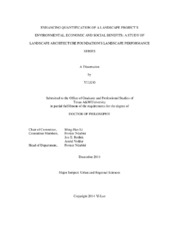| dc.description.abstract | Landscape performance is a newly initiated effort to evaluate the outcomes of landscape solutions in constructed projects. Built upon the sustainability triad, the outcomes landscape performance attempts to measure consists of environmental, economic and social aspects. These outcomes are collected and used to guide future design.
The primary purpose of this study is to enhance landscape performance measurement to better inform future decision making. To achieve this goal, I took a four step approach: 1) reviewing performance measurement in four design disciplines to learn experiences from other disciplines and provide recommendations for landscape performance measurement, 2) studying current published case studies to identify gaps in the current landscape performance quantification practices, 3) analyzing the currently used landscape metrics and methods to identify gaps, and providing recommendations for future improvement, and 4) integrating costs into the framework of landscape performance quantification and exploring economic evaluation methods to valuing non-market landscape performance benefits to facilitate cost-benefit analysis of sustainable solutions.
The results show that compared to previous performance measurements and rating systems, landscape performance is the only one with a framework that addresses the three aspects of sustainability. Its framework uses practices to guide research and simultaneously uses research results to inform practices. It has a good potential of collecting evidence for sustainable solutions and promoting measureable sustainable landscape practices. However, since landscape performance research is still new, it has a number of gaps, such as insufficient social and economic benefit quantification, insufficient cost consideration, and a lack of core prototype measuring methods and explicitly defined performance benchmarks. These gaps undermine credibility of landscape performance results and restrict its contribution to future decision making. This study helps fill these gaps by providing a number of recommendations, such as developing performance benchmarks for typical landscape solutions, developing robust core measuring systems to facilitate efficient data collection and quantification, and developing sample questionnaires to help with social benefits quantification.
The significance of this study is that it will enhance the framework of landscape performance quantification, clarify cost embedded benefits of sustainable solutions, and promote sustainable landscape design practices. | en |


